Where to go in Switzerland on a short trip: Alps, lakes, and cities
Switzerland is an extremely popular country for those planning multi-stop tours around Europe, yet very few potential first-time visitors actually know specifically where they want to go. Everyone seems to know that it has the most beautiful views of the Alps and some very impressive cities, but there are actually many misconceptions among casual trip planners, so I’d like to clear most of that up below. The places to visit in Switzerland are not obvious until you’ve been there yourself or done many hours of research, so the list below should be a short cut.
I get hundreds if not thousands of itinerary questions for people who are considering a Eurail trip around Europe, and most people just include the word “Switzerland” among a list of cities like Paris, Rome, and Berlin that they want to visit. So where in Switzerland should you go if you can only make a few stops at most? I’ll answer that question below. You’ll mostly want to focus on the best choices for Swiss Alps trips, which I’ll go over below.
Note: This article was expanded and updated in February, 2024.
Switzerland is about outdoor views rather than city visits
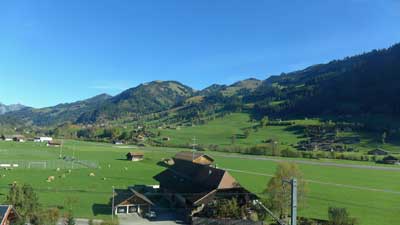
Geneva is a very famous city (though not for tourism reasons) on a lovely lake of the same name, but it’s also notoriously dull and lacking distinction. Rick Steves puts it well by saying that “Geneva is pleasantly situated on a lake, like Buffalo or Cleveland.” The point is, you don’t want to go to Geneva unless you’ve got something specific in mind that you want to see there. There are much better places to visit in Switzerland if your time is limited, or even if it’s not.
Switzerland's cities in summary
Zurich – The largest city, very expensive, geared towards business travelers. It’s generally a pretty and very well-run city that you would enjoy if you visited, but it’s not nearly as interesting as the likes of Vienna, Munich, or of course Paris.
Geneva – Second largest city, in the French part of the country, no major sights. Again, if you visited you’d be very impressed by it and get some great photos, but it’s not worth your time unless you know someone there. There’s an impressive fountain in the lake and you can usually see it from the train as you go through the city, but it’s not really worth going there and staying more than an hour or so.
Basel – Bordering France and Germany, no major sights. It has the famous art market each year, and aside from that it’s even duller than the ones above. Again, if you visited you’d be impressed, but if you later compared photos with friends who went to the Lauterbrunnen Valley instead, you’d kick yourself for going to Basel.
Lausanne – Near Geneva in the French part of the country, very hilly, and certainly more interesting than Geneva.
Bern – The capital, compact, on a lovely river, some interesting sights and the best Swiss city to get a feel for the culture. Bern is fairly close to Interlaken (which we will discuss below) and it can be a great day trip from there, especially on a day where it is foggy and/or rainy in the mountains (and this happens a LOT).
How much time and which Swiss cities to visit?
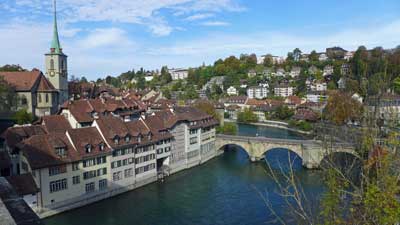
Many people (me included) don’t feel as if they’ve scratched the surface of a new country if they haven’t spent at least a day or two in the largest city. Zurich is certainly pleasant and a useful transit hub so spending one or two nights there wouldn’t be a major mistake. But Zurich isn’t even close to being a city like Paris, Rome, Berlin, Amsterdam, or even Vienna. If you skip it in favor of spending more time in the Swiss Alps, you won’t be missing much.
The 2 Best places to visit in Switzerland for short visits
Interlaken – If you want the best possible Alpine views and activities, head to the Interlaken area, which will be described in detail below. This is my favorite of all places to visit in Switzerland and it will probably be yours as well.
Lucerne – The traditional Swiss tourist retreat, Lucerne is a small city with interesting culture and sights, that is gorgeously set on a lake with plenty of top activities surrounding it.
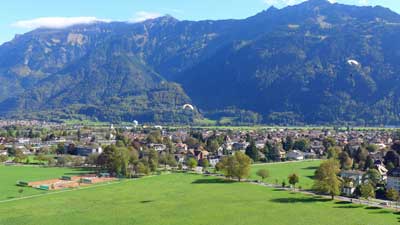
>>>Interlaken and Lucerne: Which to choose and how long to stay in each?
The article linked above will give you more details on which to choose and how long to spend in each place.
What about Zermatt for Alpine views?
Zermatt is a remote car-free village in southern Switzerland that is famous for being the place to see the Matterhorn mountain. It’s also a busy ski resort area, and aside from that, there isn’t much to see or do here. It’s on a private rail line, so it’s more complicated and usually more expensive to reach than Interlaken.
In other words, unless you’ve irrationally placed “Seeing the Matterhorn in person” on your so-called bucket list, skip Zermatt and head to Interlaken on a shorter visit. You won’t be sorry. If you already have enough time in your visit for the main sights around Interlaken and Lucerne and you want to also see the Matterhorn, then by all means go and you’ll enjoy it. There are quite a few other car-free villages in the Lauterbrunnen Valley near Interlaken, so they are not as novel in Switzerland as one might expect.
A weekend in Switzerland? What to see in 3 days
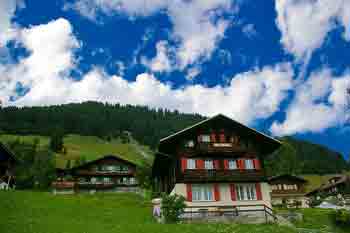
One challenge is that neither has an international airport so you’ll either be flying into Zurich or perhaps Geneva.
Train times from Zurich to Lucerne to Interlaken and back
- Zurich Airport to Lucerne: 1 hour 10 minutes by train
- Lucerne to Interlaken: 2 hours by train
- Interlaken to Zurich Airport: 2 hours 15 minutes by train
As you can see with the travel times above, Zurich Airport to Lucerne is a fairly short trip, but once you add Interlaken into the mix (even if you skip Lucerne) the travel time starts to add up for a weekend visit. With this in mind it’s probably best to just choose one of them and save the other one for another trip.
Lucerne is gorgeous, but the Lauterbrunnen Valley near Interlaken is really the star of the show, so I’d recommend going there first and doing Lucerne on another trip.
What about the Swiss Travel Pass?

The bottom line is that if you are coming to Switzerland for at least 3 days and you want to take 2 or more of the amazing scenic rail journeys that the country is famous for, the travel pass is probably a good deal. It also provides 50% discounts on the Schilthorn cable car and 25% off the Jungfraujoch mountain railway. Both of those are quite expensive on their own, but extremely worthwhile, so the discount is helpful.
The Half Fare Card is probably a better deal for most people
The Swiss Travel Pass is a good deal for those who are going to be spending at least 2 or 3 days riding the rails and seeing Switzerland that way. But if you are mostly going to be focusing on Interlaken and Lucerne and the mountain sights, the Half Fare Card is the best option. For CHF120 (about US$134) you get the card that is good for 30 days and gives you a 50% discount on all trains, cable cars, mountain railways, and other sights and attractions. If you are doing either Schilthorn or Jungfraujoch, the Half Fare Card practically pays for itself with just one of those.
>>>Buy the Swiss Half Fare Card
Many people have questions about the Swiss Half Fare Card so I will explain it a bit here. You can actually buy half price train tickets for travel within Switzerland any time you want and you will see that option when you go to buy them online. The only thing is you have to have and present a valid Half Fare Card when you get on the train and are asked to see your ticket. In other words, you can buy a half fare train ticket today and buy a Half Fare Card just before you get on that train months in the future, and you are fine.
How and why visit the area around Interlaken
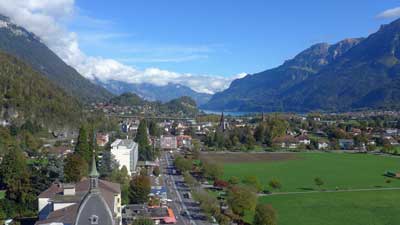
You can see everything discussed below by actually staying in a hotel in Interlaken, but it’s not the Alpine experience that you get if you stay in one of the small villages nearby. You can reach those villages in 20 to 40 minutes from the Interlaken Ost (East) train station, and it’s much easier than it sounds.
The 3 best places to stay to visit the Swiss Alps
Lauterbrunnen – A private train line runs from Interlaken Ost station to the end of its line in Lauterbrunnen. There’s a lovely waterfall here and great hiking trails, but you should probably only stay here if you can’t get to one of the villages mentioned just below. It’s a great little transit hub and it’s definitely gorgeous, so it can be worth a night if you’ve got one to spare.
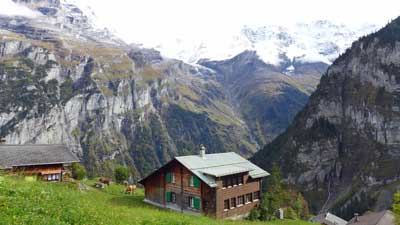
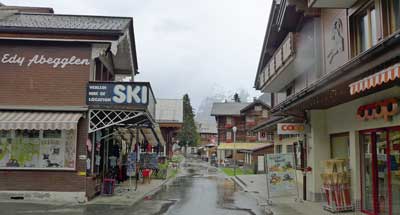
Where to stay in Interlaken and the Lauterbrunnen Valley (with pics)
I get so many questions about where to stay in the Interlaken area that I decided to write a longer version of it and load it with huge photos so readers can get a better feel for each option. I also included recommendations for affordable and well-located photos in each area.
>>>Where to stay in Interlaken and the Lauterbrunnen Valley New for 2024!
The unforgettable things to see here (if the weather is decent)
Schilthorn observation deck and restaurant
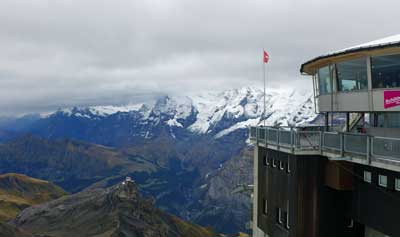
There is a rotating restaurant (with prices similar to normal Swiss restaurants) and a bizarre and anachronistic James Bond attraction based on it being a key location in the 1969 movie On Her Majesty’s Secret Service. The Bond thing is included with the lift, and it’s worth a look.
But the main thing you come here for is the 360-degree view from one of the highest peaks in Europe. Again, the weather here is key, but fortunately all the locals track the visibility on a minute-by-minute basis. If it’s clear up top while you are in the area, it would be a terrible shame to skip it based on the high price. But even if it’s cloudy up top, there are still plenty of wonderful things to see and do in the villages below.
Jungfraujoch observation area
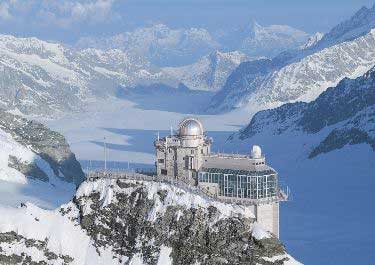
The views from the top are similar to the views from Schilthorn, from the other side of the Lauterbrunnen Valley. Once on top you can have lunch, hike, or even go sledding. It’s also quite expensive at nearly US$200 round-trip unless you have a Swiss Pass or a Eurail Pass for discounts, and it takes most of your day, but you’ll never forget the views from the top.
Harder Kulm mountain and Two Lakes Bridge Observation Deck
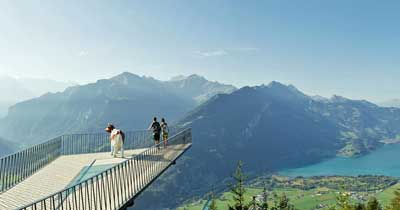
There’s a revolving restaurant about 10 minutes’ walk from the station at the top, which is definitely an unforgettable place for lunch if you’ve got time. It’s not as expensive as you might expect, at least compared to normal restaurants in Switzerland.
The Harder Kulm Railway goes from early April through late November each year. If you are only in Interlaken for one day and/or you are on a strict budget, this is the fastest and best way to get amazing Alpine views in the area.
Getting from Interlaken to Gimmelwald and Mürren
Getting up to these villages sounds complicated and time consuming, but it’s actually fast and easy once you get there. This little guide should help.
Arrive in Interlaken
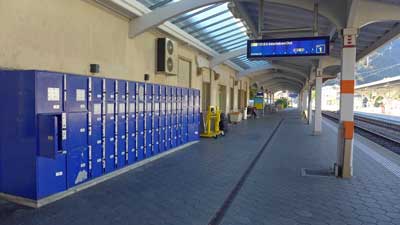
Once you arrive at the Interlaken Ost train station, head for the ticket windows in the office and buy a ticket to your final destination (Lauterbrunnen, Gimmelwald, or Mürren). Eurail passes are good for 25% discounts on the rest of the trip, but not for the whole thing.
From Interlaken Ost to Lauterbrunnen
The private train leaves Interlaken Ost every 30 minutes and arrives in Lauterbrunnen 20 minutes later. If you are staying in Lauterbrunnen then you are probably walking distance from your hotel when you reach the station.
From Lauterbrunnen to Gimmelwald
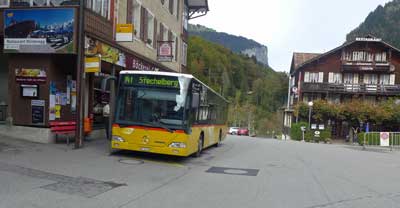

From
Gimmelwald to Mürren
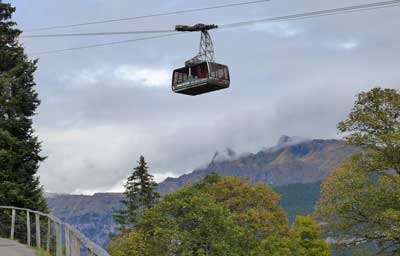
Recommended hotel and hostel in Gimmelwald
I get asked all the time about where to stay in Gimmelwald, so here it is:
Hotel: Esther’s Guesthouse
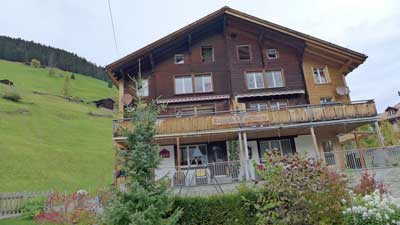
It’s run by Esther, as you might guess, and she is very friendly speaking excellent English. Each room is different and the place feels like a mountain cabin, because it is. She offers an excellent buffet breakfast in the morning, which you have to order the night before. It’s not cheap, but it’s worth it because it’s hearty and there are no other good options nearby.
Book as early as possible because this place is often the first place to sell out in Gimmelwald.
Hostel: Mountain Hostel Gimmelwald
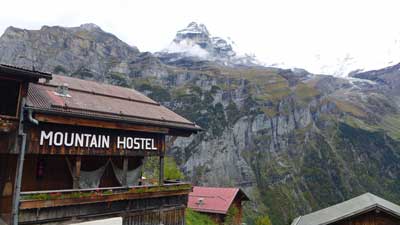
You won’t believe the views from this place, which are the same as from Esther’s except a bit lower and more unobstructed. This place also has a busy bar and restaurant that is basically the only “nightlife” in Gimmelwald. Many hikers get to bed early in this tiny village, but if you want to have a couple drinks and order a pizza or some local options, this is the place to go.
Again, book early because this place is always sold out.
Lucerne and what to do there
Luzern, as it’s spelled locally, is the other traditional holiday destination in Switzerland. Unlike Interlaken, Lucerne actually qualifies as a small city rather than a small resort town, so it’s a very nice contrast and very worthwhile. We have a new article with advice on where to stay in Lucerne and it should be helpful.
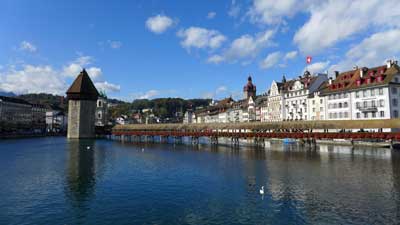
However, unlike Interlaken, the town of Lucerne itself is a great attraction and worth at least a day of exploration. This has always been a rich area so you can expect to find all of the high-end shops and boutiques along the small streets just north of the lake, but there are also many traditional shops and things to see that will appeal to anyone.
Recommended hotel in Lucerne
>>Hotel Des Alpes (3 stars with an amazing location and view)

If this place is booked, which is often the case, then book a hotel as close to it as you can find or afford. The whole historic part of town surrounding it is lovely, with restaurants, bars, and high-end shops. There are also a couple of nearby supermarkets where you can buy inexpensive alcohol and picnic supplies to keep other costs down.
Spend a day in Lucerne itself
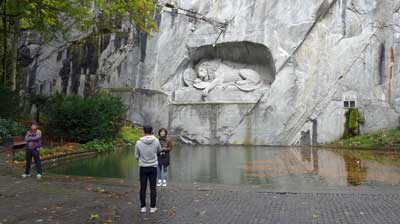
Most of the interesting part of Lucerne is in the area behind those restaurants, and it’s certainly worth doing a self-guided walking tour if not a guided one. Heading farther east you’ll come to another older part of town where the famous lion statue is located. You can’t visit Lucerne without having a look at the lion, and fortunately it’s easy and quick to reach (and it’s free).
Take a lake cruise of some kind
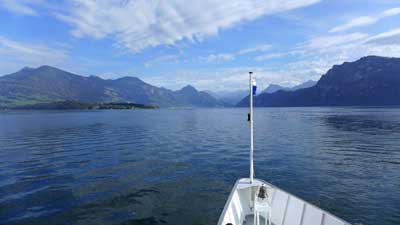
Especially in nice weather, even the short lake tour is lovely, and if you have more time you can jump off at Vitznau and do the scenic hike up Mount Rigi. There are also small lakeside villages that are ideal for a stroll and lunch stop. Long story short, there are dozens of interesting sightseeing options that are available using part of the boat tour, and the views all around are wonderful.
Visit Mount Pilatus
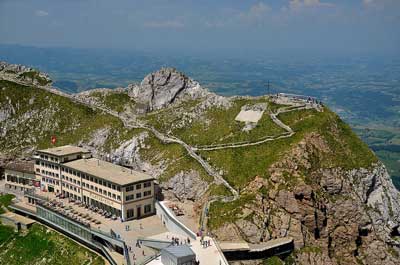
You can take the cogwheel train up and have a more or less flat hike around the summit area, and then take the gondola and cable car back down again. You can do them in the other order, and the cost is the same either way. At around US$65, this is not a cheap hike, but like most everything in Switzerland, the quality is high so it doesn’t feel like a rip-off. You can reach the cable car in 10 minutes on a public trolly bus from Lucerne.
Visit Mount Rigi
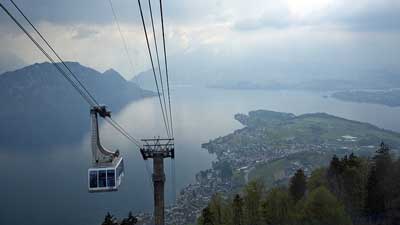
Unlike the other peaks mentioned in this article the Swiss Travel Pass covers both ways to get up and down for free. The others are 50% off with the Swiss Travel Pass or Half Fare Card, except for Jungfraujoch, which is only 25% off with the Swiss Travel Pass and still 50% off with the Half Fare Card.
Visit Mount Titlis
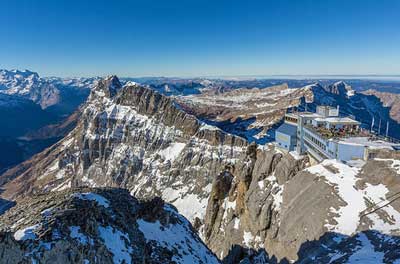
You can reach Titlis by taking a 43-minute train ride from Lucerne to Engelburg and then taking the cable car up from there. As with the others, it’s wise to check the weather immediately before you are going to depart because it can be foggy or cloudy any time of the year, but usually not for whole days at a time.
Additional photo credits
Jungfraujoch by cupweuro on Flickr, Pilatus by Tony Fernandez on Flickr, Rigi by Kosala Bandara on Flickr, Titlis by PaulSchliebs on Flickr

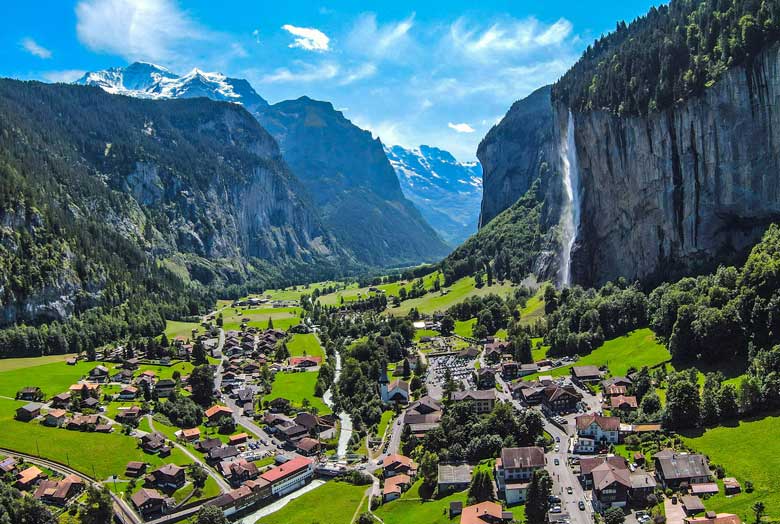
Hi Roger!
its my honey moon and i am plaaning to visit switzerland first and then paris for a total of 8 days.
i was thinking of 4 days in switzerland first. Me and my partner are more of the alps and snow kinds. so i was thinking: arrival in zurich and train to lucerne. Can you please help me as to how should i proceed from lucerne?
I wanted to see the gimmelwald, mt titlis/pilatus, interlaken, jungfrau region and the oberalp pass via the glacier express.
Can you please help me with this?
Thanks.
Vishesha,
I think flying into Zurich is a good idea and you might just go straight from there to Interlaken. In 4 days I am not sure you’ll have time to do all of the things on your list, although if you get lucky with the mountaintop weather you might be able to pull it off. As mentioned in the article, if you have time for just one place I would make it Interlaken because the views there are more dramatic than those in Lucerne. So my recommendation is 2 or 3 days in Interlaken and 1 day in Lucerne. Lucerne is closer to the Zurich Airport so it might be good to go there first and then head to Interlaken a day or two later. I would also choose Titlis or Pilatus and then also Jungfraujoch or Schilthorn for when you get to that area.
I’m not sure what other help you are looking for, but feel free to ask other questions if you have them. -Roger
Dear Roger, you were kind enough to help my husband out in another comments section when we were planning our trip to Switzerland a few weeks ago. Now our plans are firmed up we would appreciate any advice . . .
We are a couple from Singapore in our 50s. We enjoy staying in a few locations over a few nights rather than moving around too much. So we will be making Basel our base for seven days (12th to 19th September), then Lucerne for another seven days (19th to 26th September).
In Basel our plan is:
Day 1: Get to know Basel (eg walking tours and markets)
Day 2 – 6: Day trips from Basel. We would like to visit
The Alsace region – Colmar, Strasbourg, Saint Louis, Lorrach
Frieburg in Germany
Bern
In Lucerne our plan is:
Day 1: Get to know Lucerne
Days 2 – 6: Day trips from Lucerne. We would like to visit
Zurich,
Mt. Pilatus
Interlaken
Liechtenstein
We are more fans of towns and cities rather than mountains (though of course we will try to see them too!).
We know you are not the biggest fan of Bern (maybe you could suggest places to get away from there!) We know you do like Lucerne – we would appreciate any advice, ways of getting around and suggestions for other places to visit or activities in both towns.
Thanks for this and a truly inspiring website!
BUMM,
It looks like your plans are firming up and I’m sure you’ll love it. Actually, I really like Bern, but I find Basel to be a bit dull. Again, it’s partly because my brother lives so close and it doesn’t feel all that special to me. If you flew right from Singapore to Basel and this was your first time in Europe I’m sure you’d love it. However, if you spent 3 days in Basel and then 3 days in Paris, Barcelona, Amsterdam, Berlin, and other cities like that, I think you’d put Basel near the bottom of the list in the end.
You’ll definitely want to get around by train and I think since you are staying so long the Swiss Rail Pass will be great value. The Swiss trains are very comfortable and famously punctual, so you can just hop on any of them and you’ll almost always arrive exactly on time.
I tend not to like to recommend lists of things people should see and do, and I prefer to help people figure out where to stay and how long and that sort of thing. I’m also a big guidebook fan and a big fan of an American writer named Rick Steves. If you can get a digital copy of Rick Steves Switzerland it will be the best US$20 or so you spend on this whole trip. The books are really well organized and easy to use, and he covers all of the best areas in detail. His advice is far better than mine so I hope you can order a copy online. If not I’d get Lonely Planet Switzerland or something like that. Have a fantastic trip and let me know if you have any other specific questions. -Roger
Thank you very much for the quick response. Your extensive knowledge is is very helpful and greatly appreciated.
Can you please comment on the Scenic Rail Journeys. Is the scenery any different or better by taking these special trains. I am a bit confused to what is the advantage of taking the scenic train routes like the william Tell (Gotthard )Express train or the Golden Pass. Do standard trains use the same path? Will I be missing anything from the experience if I took the standard trains to get to Varenna?
thank you
lena
Lena,
I haven’t done all of the scenic trains so I can’t say for sure, but in my opinion it’s not really necessary to restrict yourself to the scenic routes. Yes, most of the trains on those routes are normal carriages, and the scenic trains tend to have a few panoramic carriages on a few departures per day. Those carriages look really nice and if you have an opportunity to book one I’m sure you’d enjoy it. But honestly just about every train ride in Switzerland is very scenic. In fact, the normal trains between Interlaken and Milan are fantastic, as are the ones between Zurich and Venice. Also, the GoldenPass is nice, but some sections are much more dramatic than others. The best section in my opinion is between Spiez and Montreux.
My advice to most visitors is simply to book trains between the places you want to visit in Switzerland, and even the normal carriages are wonderful. If you can upgrade to a panoramic carriage then great, but you’ll be very impressed by the normal carriages and the views are pretty amazing all over (once you get out of Zurich). The train to the Lake Como area will be one of the better ones, whether it’s a special train or not. -Roger
Hello Roger,
Can you please respond to my posting on July 9th. I would really appreciate your feedback on what pass to buy and some of my questions about our planned trip.
I also want to add, are the scenic trains worth while taking. Getting to Varenna from Luzern – is it worth while to take the Willian Tell Scenic train or should we just stick to the regular trains.
Lena,
Sorry about that. I just responded to that previous comment. -Roger
Hi Roger,
First of your knowledge on Switzerland is highly commendable.
I would like to have your advice and pointers on my vacation to Switzerland.
Although , I have been to Switzerland before as well but then it was quite hectic trip as we covered 4 cities in 4 days. This time though, I would like to visit some village in the mountains. Would like to spend like full 4-5 days there. Enjoy the nature to the fullest.
Which place would you recommend?
Thanks in advance.
Best Regards,
Prashant
Prashant,
This is a tough question to answer because Switzerland is so full of scenic and lovely villages. Gimmelwald is the one I mention in the article above and I highly recommend it for a day or two. It’s tiny, consisting of maybe 40 or 50 farms and a handful of hotels and a few restaurants, with a magical location perched on the side of a mountain above Lauterbrunnen. Murren is a larger village just above Gimmelwald, with far more to see and do, but it’s very touristy rather than a farming village. In that same area there is Lauterbrunnen on the valley floor as well as Wengen. And Grindelwald is another larger town but still gorgeous with a beautiful location. Those are all in the same area near Interlaken.
One wonderful thing about Switzerland is that you can go almost anywhere in the country, and as long as you avoid the largest cities (Zurich, Geneva, Basel) you’ll be in what feels like a charming small town or village. I hope this helps. -Roger
Hello Roger,
I would greatly appreciate your feedback on our trip to Switzerland in September. I love your website, it has been a great help in trying to plan our trip. All the information has been so valuable. I am slightly confused re which pass to get. Here are the details of my trip:
Day 1: Arrive Basel, take the train to Lauterbrunnen –
Day 2: Murren – Gimmelwald – Schilthornbahn
Day 3 : Jungfraubahn – should we spend some time in Grindelwald?
-appreciate some suggestions for easy walking/hiking trails in these areas.
Day 4: site seeing in Bern- day trip ( not sure if to do this, would you recommend something else for the day?). Or should we do the Golden Pass scenic train ride.
Day 5 : train to Luzern – spend the day site seeing
Day 6: mount pilatus or Rigi – not sure which one to do, is it even worth to do any of them if we spent all that time in interlaken?appreciate your feedback.
Day 7 – take William Tell Express to Lake Como ( need some information the best way to get to Varenna from Lugano -should be take the Bernina Express or is there another simpler route)?
Not sure to get the 8 day Swiss Pass (considering we will only be there for 7 days) or the Half card.
– I am open to any recommendations you have re my trip above. Any other things that should be on my to do list.
-Should we buy our swiss pass at Basel Airport or on line?
-any Chocolate tours or chocolatiers in Interlaken or ,Luzern you would recommend ?
Looking forward to your feedback.
Thank you, Lena
Lena,
Sorry about missing this comment. Once in a while one gets by me. Your itinerary looks really good. My guess is that an 8-day Swiss Travel Pass would save you the most money, but the Half Fare Card might be close and the only way to be sure is to add it all up. And as I often say, if it’s close between the two I would get the Pass because you’ll find other things to do with it to get even better value than you expect.
Grindelwald is one of many really lovely villages in that area and walking around town a bit could be enjoyable. I haven’t done all the hikes around there, but one very popular one to consider is reached from the cable car in Wengen. You take the cable car to the top and then there is a small peak you can reach from there, but most of the walk is level and downhill to the next train station down. It’s very scenic if the weather is nice, and it’s mostly level or downhill.
If you get the Swiss Travel Pass I’d do Mt Rigi on Day 6 since it’s included. It’s not as dramatic as Schilthorn and Jungfraujoch, but it’s a fun trip up a cable car and down a train or vice versa, and you can do it as part of a boat trip on the lake that is also included.
From Lugano to Varenna you can either take a train towards Milan and then switch for the train going to Varenna, or I think there is a local bus that goes from Lugano to Menaggio, which is just across from Varenna on the ferry. At least those were the options last time I researched it.
I think your plan looks really well thought out. As I often say, it’s best to be a bit flexible with the mountain peaks because it can be foggy or rainy on top any day of the year, though it’s rare for it to be bad all day.
I would buy the Swiss Travel Pass online and print it from home, but you can also buy it in Basel if you prefer. I’m not aware of any specific chocolate tours, although I know there are at least a few good options. Have a great trip. -Roger
Thanks roger for the encouraging words!
When you plan a trip like this how do you usually keep track of spending? and planning how much you actually need for a trip? I realize a 6 week trip isn’t going to be cheap but i know if i stick to hostels and Occasionally treat myself to a private room that and food will probably be the most expensive.
I just wasn’t sure what to expect, i see most articles said around $80 a day with hostel and food.
Also is there anything to keep in mind when staying at hostels? i was warned there could be bed bugs or Cockroaches? not sure if this is actually true.
Lastly did you run into any issue with theft? since being a American i know in certain cities they say have your backpack in front of you but think that may be a little overkill.
Thanks roger for the encouraging words!
When you plan a trip like this how do you usually keep track of spending? and planning how much you actually need for a trip? I realize a 6 week trip isn’t going to be cheap but i know if i stick to hostels and Occasionally treat myself to a private room that and food will probably be the most expensive.
I just wasn’t sure what to expect, i see most articles said around $80 a day with hostel and food.
Also is there anything to keep in mind when staying at hostels? i was warned there could be bed bugs or Cockroaches? not sure if this is actually true.
Lastly did you run into any issue with theft? since being a American i know in certain cities they say have your backpack in front of you but think that may be a little overkill.
Arjuna,
Interestingly enough, the backbone of this website are the pages that list the costs in each city, and it’s all summarized in the Europe Backpacker Index. That list will give you an approximate daily cost of 56 different cities in Europe, and it should be pretty close.
Keeping track of spending is a personal thing. Some people plan it all ahead of time and write down literally everything they spend, and other people just wing it and hope to have enough to get through the trip.
Most hostels in Europe are very nice. Pay close attention to the reviews on hostelworld, but only the places with a LOT of reviews because a new hostel with only 30 or 40 reviews probably paid for most of those. My preference is to book the most popular hostel in each city that gets great reviews. I have each of those listed on that Backpacker Index page so you can start looking there. I don’t think bedbugs or cockroaches are common, at least at established popular hostels. If they were you’d see it in the reviews.
Weirdly enough, some petty crimes are more common in large European cities than in the US, and that includes pickpocketing and that sort of thing. It’s good to be cautious and I’d read an article or two about keeping safe over there, but I’ve literally spent years in Europe and been everywhere and not had an issue myself. Have a great trip. -Roger
Thank you, Roger, My first decider where to go is finding affordable flights
here’s what i’ve map out so far
Newark NJ to London, have cousins there visit 5 days, fly from London to Wroclaw heard its Beautiful, catch a train to Prague, visit a couch surfer friend who stayed with me, than Brno 2 nights, down to Vienna, detour over to Budapest many people have mentioned i should stop there back up to Vienna to get to Graz don’t think i can get there any quicker beside going back up.
From this point i hit a stopping point do i go down to Slovenia and Croatia?
Or continue through Austria and head to Switzerland and down to Milan, Venice, Florence and finally to Rome where i fly back home? or From Switzerland head straight to France.
Now i am self employed so i could make this a 3 month trip which i probably couldn’t afford, But planning a 5 to 6 week backpack trip, my biggest worry is getting there and getting Completely overwhelmed by their public transportation,
i did download Rome2rio which seems to make things less Intimidating, i was told to get a Europe Rail Pass and International Hostel Card.
So my biggest questions to you a man who’s not only lived there but traveled many times is
1 what countries have the best nature landscapes?
2 what should any traveler going to Europe know before leaving?
3 Besides asking friends or googling what to do in certain cities or areas find out the really unique stuff to see
4 lastly not doubting your every decision.
-Arjuna
Arjuna,
I’ll be happy to try to help.
1. Switzerland has amazing scenery all over, but Austria, France, and Italy have lovely scenery in their Alpine regions (plus some others). Slovenia is known for its scenery, especially Lake Bled and the Karst hills. Croatia has a really lovely coastline and the Plitvice Falls National Park is one of Europe’s finest scenic areas.
2. It’s intimidating before you get there and scary as well, but after only a few days on a trip like this you’ll start to feel like a pro. Almost everyone you encounter speaks enough English to help you do whatever they are involved with. Learning a few words in each language is great and it helps break the ice, but don’t bother trying to learn too much because you’ll end up speaking English almost all the time anyway.
3. This is a tough one. I’d say my best advice would be to research online (lonelyplanet.com, wikitravel.org etc) and then also ask the front desk of a hostel or budget hotel once you get there. The cheaper the place the more likely they will tell you about the interesting things rather than the expensive tours and things they get commission on.
4. I don’t understand this as a question, but I really do believe you’ll feel comfortable and confident only a few days into your trip. Let me know if you have other questions. -Roger
Hi,
First many thanks for your info. Without that i would have ended up in Geneva for whole my trip!
I need to spend 3 days in Geneva and then planning to spend 2-3 days in Interlaken (where my hotel will be) and see Lauterbrunnen, Gimmelwald, Mürren and Schilthorn. From your info, i am planning to take a combination of train and bus and cable car to get to the top in one day (not sure if it is doable?). But i saw another cable car (https://schilthorn.ch/cmsfiles/tariffs_schilthorn_abjuni_2018_english.pdf ) between Interlaken – Lauterbrunnen – Grütschalp – Mürren – Schilthorn –Stechelberg – Lauterbrunnen – Interlaken.
Could you please let me know which one is better? the route you suggested or using this cable car? it seems it is cheaper but i will miss some of villages you recommended in the latter?
Thanks,
Hanna
Hanna,
I’m sure you’ll love the Interlaken area. That page you linked to is yet another very confusing part of the Switzerland puzzle and they don’t explain it well. The Schilthorn observation deck (along with the Piz Gloria restaurant and James Bond attraction) are at the top of a series of cable cars starting in Stechelberg going to Gimmelwald then to Murren then another two stops on the way up. However, there is a train from the other end of Murren that also goes down to Grütschalp in the valley floor, so it’s possible to do a “round-trip” where you go up two short cable cars to Murren and then on your way down you walk through town to the train station on the other end. If you have time for that it’s probably worthwhile, and of course you can go up that way too, but the main attraction is just the cable car series from Murren to Schilthorn itself.
One other option to consider is to get off the cable car in Murren on the way down and walk around town a bit and then walk down about 15 minutes (all downhill on a nice path) into Gimmelwald, which is a tiny farming village. The path through Gimmelwald ends at the cable car station there, so it’s a lovely walk and then you can get on the next cable car down. They run in both directions every 30 minutes. Let me know if you have any other questions. -Roger